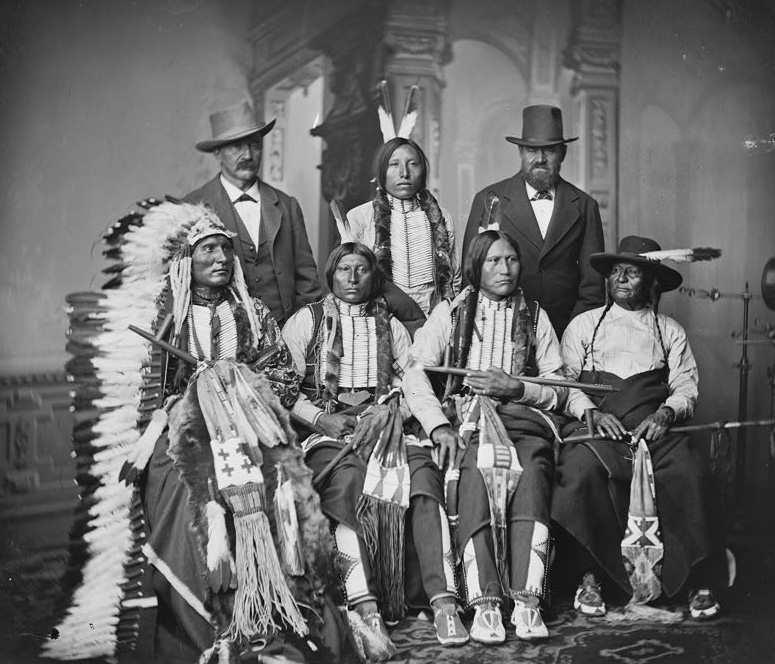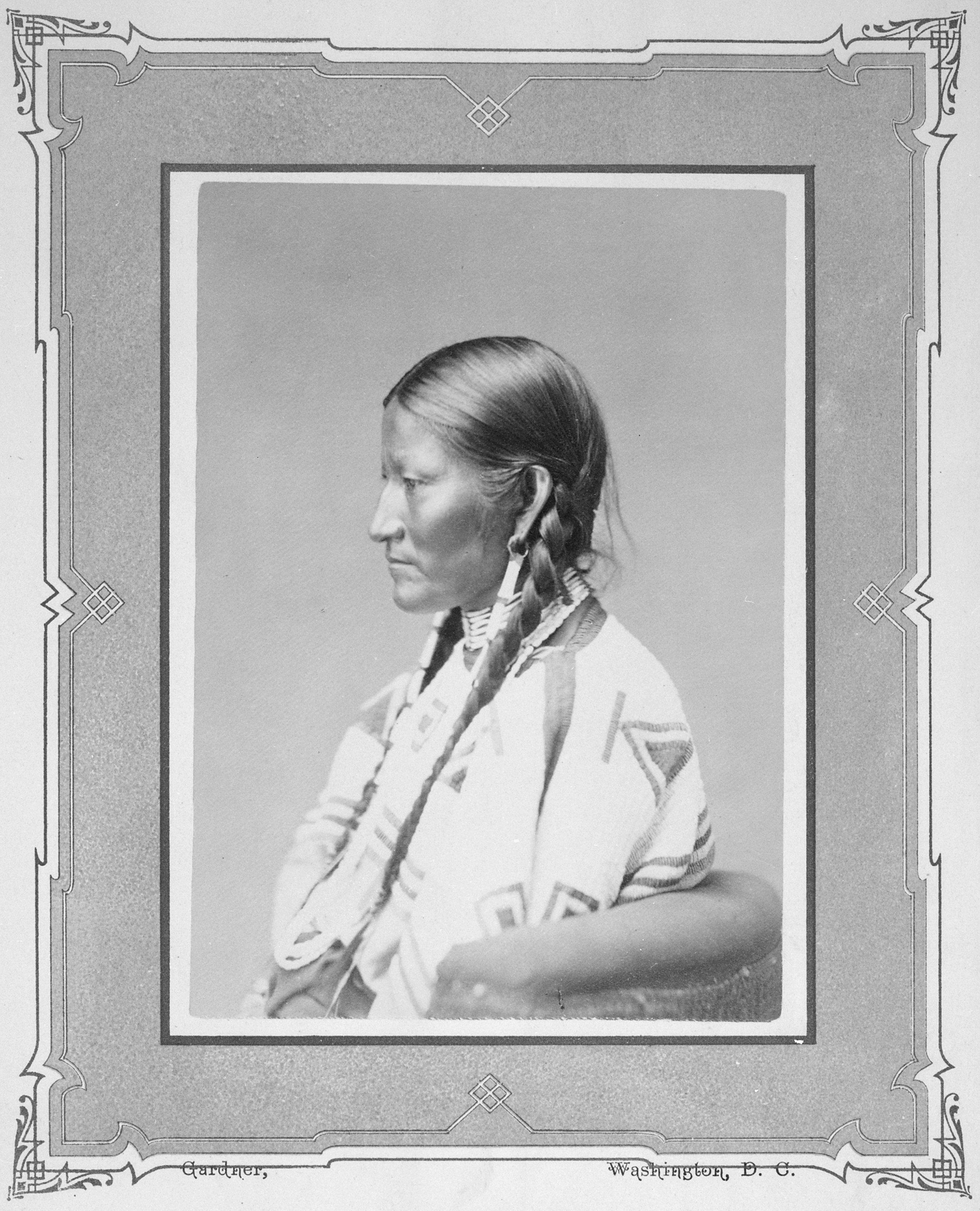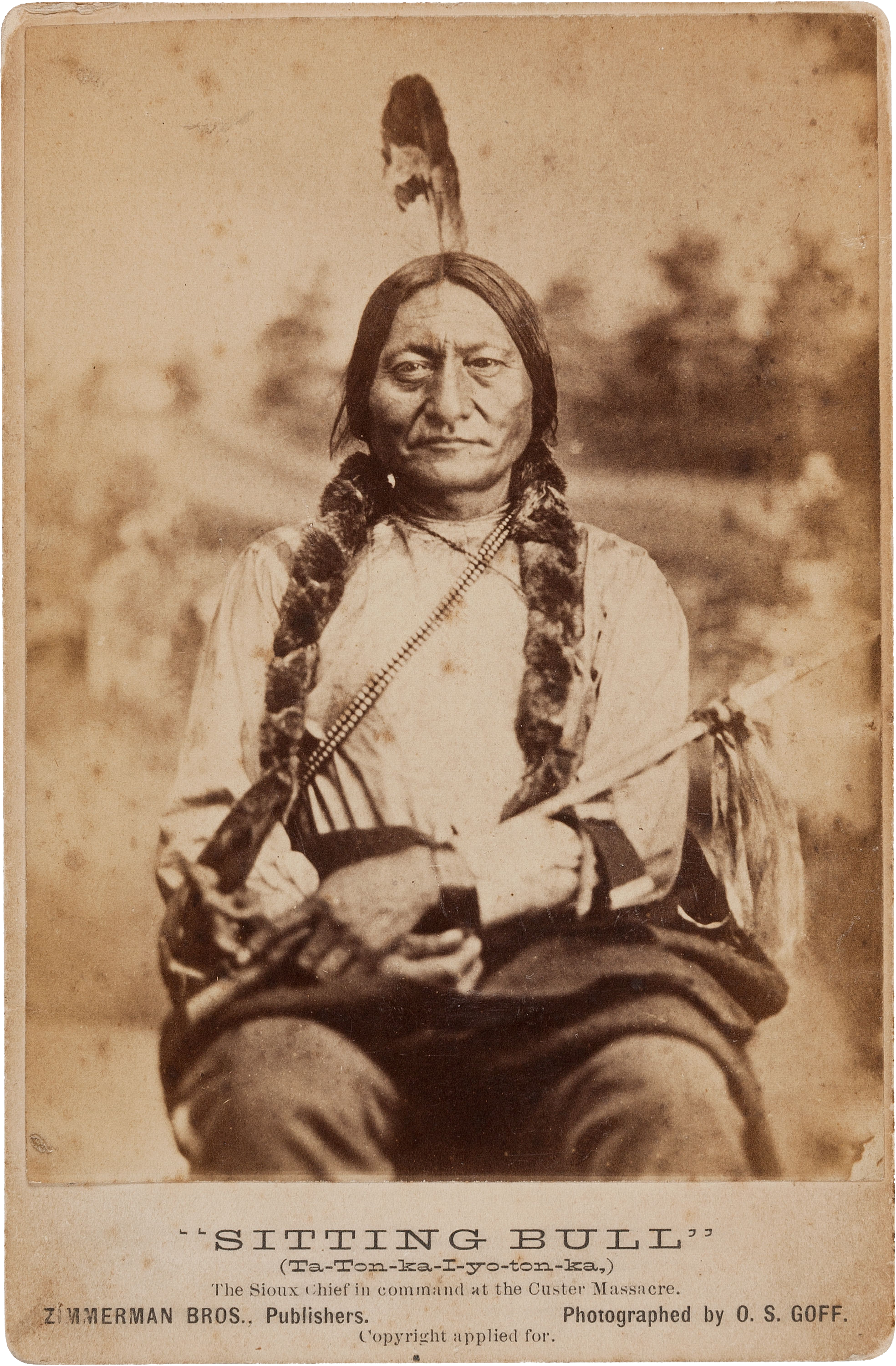|
Mahpia Icahtagya
Touch the Clouds ( Lakota: Maȟpíya Ičáȟtagya or Maȟpíya Íyapat'o) (c. 1838 – September 5, 1905) was a chief of the '' Minneconjou'' Teton Lakota (also known as Sioux) known for his bravery and skill in battle, physical strength and diplomacy in counsel. The youngest son of Lone Horn, he was brother to Spotted Elk, Frog, and Roman Nose. There is evidence suggesting that he was a cousin to Crazy Horse. When Touch the Clouds's ''Wakpokinyan'' band split in the mid-1870s, the band traveled to the Cheyenne River Agency. He assumed the leadership of the band in 1875 after the death of his father and retained leadership during the initial period of the Great Sioux War of 1876-77. After the Battle of the Little Bighorn, he took the band north, eventually surrendering at the Spotted Tail Agency, where he enlisted in the Indian Scouts. However, not long after being present at the death of Crazy Horse, Touch the Clouds transferred with his band back to the Cheyenne River ... [...More Info...] [...Related Items...] OR: [Wikipedia] [Google] [Baidu] |
Minneconjou
The Miniconjou (Lakota: Mnikowoju, Hokwoju – ‘Plants by the Water’) are a Native American people constituting a subdivision of the Lakota people, who formerly inhabited an area in western present-day South Dakota from the Black Hills in to the Platte River. The contemporary population lives mostly in west-central South Dakota. Perhaps the most famous Miniconjou chief was Touch the Clouds. Historic Miniconjou thiyóšpaye or bands Together with the Sans Arc (''Itázipčho'', ''Itazipcola'', ''Hazipco'' - ‘Those who hunt without bows’) and Two Kettles (''Oóhe Núŋpa'', ''Oóhenuŋpa'', ''Oohenonpa'' - ‘Two Boiling’ or ‘Two Kettles’) they were often referred to as ''Central Lakota'' and divided into several ''bands'' or ''thiyóšpaye'': * Unkche yuta (‘Dung Eaters’) * Glaglaheca (‘Untidy’, ‘Slovenly’, ‘Shiftless’) * Shunka Yute Shni (‘Eat No Dogs’, split off from the ''Wanhin Wega'') * Nige Tanka (‘Big Belly’) * Wakpokinyan (‘Fl ... [...More Info...] [...Related Items...] OR: [Wikipedia] [Google] [Baidu] |
Lame Deer
Lame Deer (1821-1877), also called "The Elk that Whistles Running," was a first chief of the Miniconjou Lakota (trans. "They who plant by the water") and vice chief of the Wakpokinyan (trans. "To Fly along the river") band. Biography Lame Deer was the second signatory of the 186Treaty With The Sioux-Miniconjou Bandat Fort Sully, Dakota Territory (now just southeast of Pierre, South Dakota): "Tah-ke-chah-hoosh-tay, The Lame Deer, 1st chief of the Minneconjon band of Dakota or Sioux Indians". This group of Lakota were opposed to the 1868 Treaty of Fort Laramie, which required the Lakota to cede much of their territory to the United States. Lame Deer's band of Miniconjou participated in all of the fighting against United States troops during the Sioux War of 1876, including the Battle of the Greasy Grass, also known as the Battle of the Little Bighorn, where the combined Lakota and allied forces dealt an overwhelming defeat to United States forces. Until 1877, Lame Deer and his ... [...More Info...] [...Related Items...] OR: [Wikipedia] [Google] [Baidu] |
George Crook
George R. Crook (September 8, 1828 – March 21, 1890) was a career United States Army officer, most noted for his distinguished service during the American Civil War and the Indian Wars. During the 1880s, the Apache nicknamed Crook ''Nantan Lupan'', which means "Grey Wolf." Early life and military career Crook was born to Thomas and Elizabeth Matthews Crook on a farm near Taylorsville, Ohio. Nominated to the United States Military Academy by Congressman Robert Schenck, he graduated in 1852, ranking near the bottom of his class. He was assigned to the 4th U.S. infantry as brevet second lieutenant, serving in California, 1852–61. He served in Oregon and northern California, alternately protecting or fighting against several Native American tribes. He commanded the Pitt River Expedition of 1857 and, in one of several engagements, was severely wounded by an Indian arrow. He established a fort in Northeast California that was later named in his honor; and later, Fort Ter-W ... [...More Info...] [...Related Items...] OR: [Wikipedia] [Google] [Baidu] |
Nebraska
Nebraska () is a state in the Midwestern region of the United States. It is bordered by South Dakota to the north; Iowa to the east and Missouri to the southeast, both across the Missouri River; Kansas to the south; Colorado to the southwest; and Wyoming to the west. It is the only triply landlocked U.S. state. Indigenous peoples, including Omaha, Missouria, Ponca, Pawnee, Otoe, and various branches of the Lakota ( Sioux) tribes, lived in the region for thousands of years before European exploration. The state is crossed by many historic trails, including that of the Lewis and Clark Expedition. Nebraska's area is just over with a population of over 1.9 million. Its capital is Lincoln, and its largest city is Omaha, which is on the Missouri River. Nebraska was admitted into the United States in 1867, two years after the end of the American Civil War. The Nebraska Legislature is unlike any other American legislature in that it is unicameral, and its members are elected ... [...More Info...] [...Related Items...] OR: [Wikipedia] [Google] [Baidu] |
Spotted Tail
Spotted Tail (Siŋté Glešká pronounced ''gleh-shka''; birth name T'at'aŋka Napsíca "Jumping Buffalo"Ingham (2013) uses 'c' to represent 'č'. ); born c. 1823 – died August 5, 1881) was a Brulé Lakota tribal chief. Although a great warrior in his youth, and having taken part in the Grattan massacre, he declined to participate in Red Cloud's War. He had become convinced of the futility of opposing the white incursions into his homeland; he became a statesman, speaking for peace and defending the rights of his tribe. He made several trips to Washington, D.C. in the 1870s to represent his people, and was noted for his interest in bringing education to the Sioux. He was shot and killed by Crow Dog, a Brulé Lakota subchief, in 1881 for reasons which have been disputed. Early years Spotted Tail was born about 1823 in the White River country west of the Missouri River in present-day South Dakota. His father, Cunka or Tangle Hair, was from the Saône band, and his moth ... [...More Info...] [...Related Items...] OR: [Wikipedia] [Google] [Baidu] |
Brulé
The Brulé are one of the seven branches or bands (sometimes called "sub-tribes") of the Teton (Titonwan) Lakota American Indian people. They are known as Sičhą́ǧu Oyáte (in Lakȟóta) —Sicangu Oyate—, ''Sicangu Lakota, o''r "Burnt Thighs Nation". Learning the meaning of their name, the French called them the ''Brûlé'' (literally, "burnt"). The name may have derived from an incident where they were fleeing through a grass fire on the plains. Distribution Many Sičhą́ǧu people live on the Rosebud Indian Reservation in southwestern South Dakota and are enrolled in the federally recognized Rosebud Sioux Tribe, also known in Lakȟóta as the ''Sičhą́ǧu Oyáte.'' A smaller population lives on the Lower Brule Indian Reservation, on the west bank of the Missouri River in central South Dakota, and on the Pine Ridge Indian Reservation, also in South Dakota, directly west of the Rosebud Indian Reservation. The different federally recognized tribes are politically inde ... [...More Info...] [...Related Items...] OR: [Wikipedia] [Google] [Baidu] |
Little Missouri River (North Dakota)
The Little Missouri River is a tributary of the Missouri River, 560 miles (901 km) long, in the northern Great Plains of the United States. Rising in northeastern Wyoming, in western Crook County about 15 miles (24 km) west of Devils Tower, it flows northeastward, across a corner of southeastern Montana, and into South Dakota. In South Dakota, it flows northward through the Badlands into North Dakota, crossing the Little Missouri National Grassland and both units of Theodore Roosevelt National Park. In the north unit of the park, it turns eastward and flows into the Missouri in Dunn County at Lake Sakakawea, where it forms an arm of the reservoir 30 miles (48 km) long called Little Missouri Bay and joins the main channel of the Missouri about 25 miles (40 km) northeast of Killdeer. The highly seasonal runoff from badlands and other treeless landscapes along the Little Missouri carries heavy loads of eroded sediment downstream. The sedimentary layers, which ... [...More Info...] [...Related Items...] OR: [Wikipedia] [Google] [Baidu] |
Nelson Miles
Nelson Appleton Miles (August 8, 1839 – May 15, 1925) was an American military general who served in the American Civil War, the American Indian Wars, and the Spanish–American War. From 1895 to 1903, Miles served as the last Commanding General of the United States Army, before the office was retooled as Chief of Staff of the Army. Early life Miles was born in Westminster, Massachusetts, on his family's farm. He worked in Boston, read military history, and mastered military principles and techniques, including battle drills. He attended Fort Wayne College. Civil War Miles was working as a crockery store clerk in Boston when the American Civil War began. He entered the Union Army as a volunteer on September 9, 1861, and fought in many crucial battles. He became a lieutenant in the 22nd Regiment Massachusetts Volunteer Infantry and was commissioned a lieutenant colonel of the 61st New York Volunteer Infantry Regiment on May 31, 1862. He was promoted to colonel after the B ... [...More Info...] [...Related Items...] OR: [Wikipedia] [Google] [Baidu] |
Sitting Bull
Sitting Bull ( lkt, Tȟatȟáŋka Íyotake ; December 15, 1890) was a Hunkpapa Lakota leader who led his people during years of resistance against United States government policies. He was killed by Indian agency police on the Standing Rock Indian Reservation during an attempt to arrest him, at a time when authorities feared that he would join the Ghost Dance movement. Before the Battle of the Little Bighorn, Sitting Bull had a vision in which he saw many soldiers, "as thick as grasshoppers", falling upside down into the Lakota camp, which his people took as a foreshadowing of a major victory in which many soldiers would be killed. About three weeks later, the confederated Lakota tribes with the Northern Cheyenne defeated the 7th Cavalry under Lt. Col. George Armstrong Custer on June 25, 1876, annihilating Custer's battalion and seeming to bear out Sitting Bull's prophetic vision. Sitting Bull's leadership inspired his people to a major victory. In response, the U.S. governm ... [...More Info...] [...Related Items...] OR: [Wikipedia] [Google] [Baidu] |
Tongue River (Montana)
The Tongue River is a tributary of the Yellowstone River, approximately 265 mi (426 km) long, in the U.S. states of Wyoming and Montana. The Tongue rises in Wyoming in the Big Horn Mountains, flows generally northeast through northern Wyoming and southeastern Montana, and empties into the Yellowstone River at Miles City, Montana. Most of the course of the river is through the beautiful and varied landscapes of eastern Montana, including the Tongue River Canyon, the Tongue River breaks, the pine hills of southern Montana, and the buttes and grasslands that were formerly the home of vast migratory herds of American bison. The Tongue River watershed encompasses parts of the Cheyenne and Crow Reservations. The headwaters lie on the Bighorn National Forest, and the watershed encompasses the Ashland Ranger District of the Custer National Forest. The river's name corresponds to Cheyenne ''/vetanoveo'he/'', where ''/vetanove/'' means "tongue" and ''/o'he'e/'' means "river". Geog ... [...More Info...] [...Related Items...] OR: [Wikipedia] [Google] [Baidu] |
Chief Spotted Elk
Spotted Elk (Lakota: Uŋpȟáŋ Glešká, sometimes spelled ''OH-PONG-GE-LE-SKAH'' or ''Hupah Glešká'': 1826 approx – ), was a chief of the Miniconjou, Lakota Sioux. He was a son of Miniconjou chief Lone Horn and became a chief upon his father's death. He was a highly renowned chief with skills in war and negotiations. A United States Army soldier, at Fort Bennett, coined the nickname (Si Tȟáŋka) – not to be confused with (also known as ''Ste Si Tȟáŋka'' and ''Chetan keah'').Michno, 303 In 1890, he was killed by the U.S. Army at Creek, Pine Ridge Indian Reservation ''Wazí Aháŋhaŋ Oyáŋke''), South Dakota, USA with at least 150 members of his tribe, in what became known as the Wounded Knee Massacre. Early life Spotted Elk (Lakota: Uŋpȟáŋ Glešká) was born about 1826, the son of Lakota Sioux chief Lone Horn (''Heh-won-ge-chat''). His family belonged to the Miniconjou ("Planters by the River") subgroup of the Teton Lakota (Sioux) ... [...More Info...] [...Related Items...] OR: [Wikipedia] [Google] [Baidu] |






